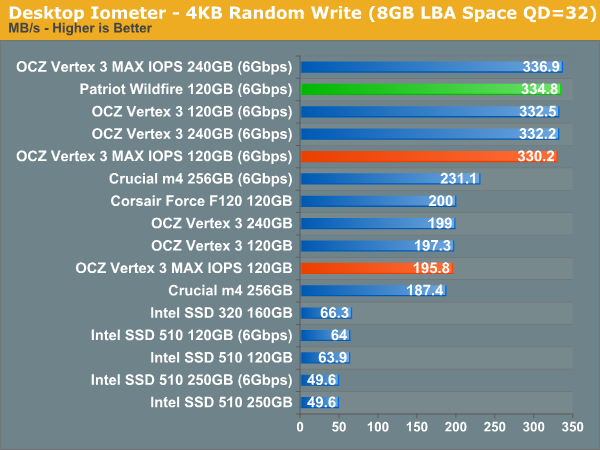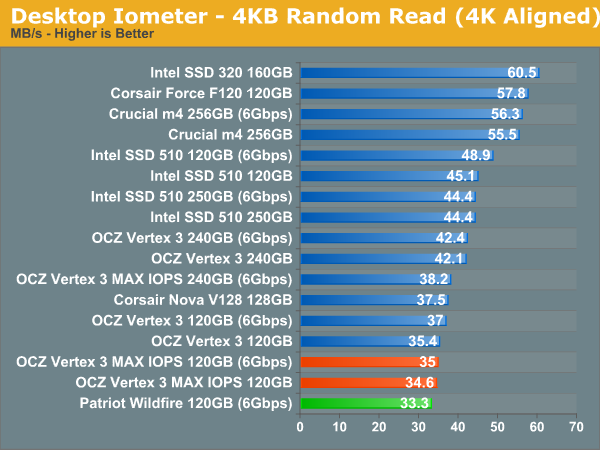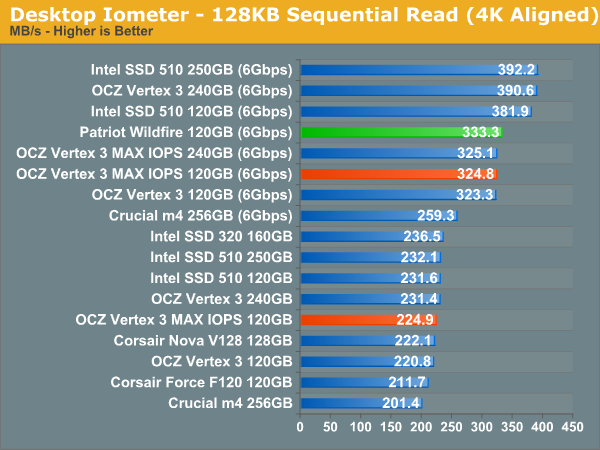OCZ Vertex 3 MAX IOPS & Patriot Wildfire SSDs Reviewed
by Anand Lal Shimpi on June 23, 2011 4:35 AM ESTRandom Read/Write Speed
The four corners of SSD performance are as follows: random read, random write, sequential read and sequential write speed. Random accesses are generally small in size, while sequential accesses tend to be larger and thus we have the four Iometer tests we use in all of our reviews.
Our first test writes 4KB in a completely random pattern over an 8GB space of the drive to simulate the sort of random access that you'd see on an OS drive (even this is more stressful than a normal desktop user would see). I perform three concurrent IOs and run the test for 3 minutes. The results reported are in average MB/s over the entire time. We use both standard pseudo randomly generated data for each write as well as fully random data to show you both the maximum and minimum performance offered by SandForce based drives in these tests. The average performance of SF drives will likely be somewhere in between the two values for each drive you see in the graphs. For an understanding of why this matters, read our original SandForce article.

The numbers here are what you'll see echoed throughout the entire review. The 120GB Wildfire and Vertex 3 MAX IOPS perform like a 240GB Vertex 3. The Patriot and OCZ drives perform identically as they are similarly equipped.
Many of you have asked for random write performance at higher queue depths. What I have below is our 4KB random write test performed at a queue depth of 32 instead of 3. While the vast majority of desktop usage models experience queue depths of 0 - 5, higher depths are possible in heavy I/O (and multi-user) workloads:


Sequential Read/Write Speed
To measure sequential performance I ran a 1 minute long 128KB sequential test over the entire span of the drive at a queue depth of 1. The results reported are in average MB/s over the entire test length. These results are going to be the best indicator of large file copy performance.












112 Comments
View All Comments
DrBungle - Tuesday, August 2, 2011 - link
My config;Asus G73
Core i7 2630
8GB RAM
Shipped with 2 X 500GB 7200PRM HDDs
I pulled the OS drive and replaced it with a Vertex 3. I had stutter issues for the first couple days, that was corrected with 2.09 firmware.
Since then, I've had over 2 months of problem free computing. Large file transfers, extractions, transcodings and countless hours of Bad Company 2 (in preparation for BF3) with not ONE BSoD or even mild hiccup.
Am I the only person in the universe who really likes this drive?
It simply can't be that my notebook computer is somehow magically circumventing some critical flaw with this drive. The term "PEBCAK" comes to mind with a lot of the complaints I hear.
RTFM. (Read The Forums Man). If you want plug and play simplicity, stick with HDDs. Personally, I like a new challenge every now and then but my Vertex 3 certainly wasn't one of them.
umesh - Tuesday, February 28, 2012 - link
In the PC Mark Vantage tests, why is there no trace of the OCZ Vertex 3 240 GB Max IOPS drive at all? Was it not tested or what? Please enlighten me.